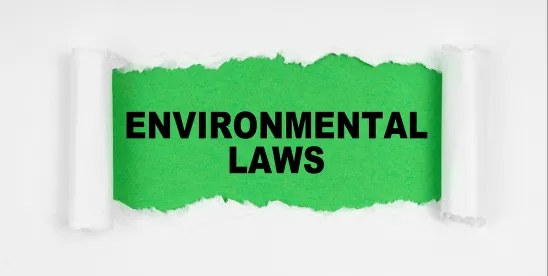On February 20, 2025, the White House Council on Environmental Quality (CEQ) posted a pre-publication notice on its website of an Interim Final Rule that rescinds its regulations implementing the National Environmental Policy Act (NEPA), which, in one form or another, have guided NEPA practice since 1978. CEQ simultaneously issued new guidance to federal agencies for revising their NEPA implementing procedures consistent with the NEPA statute and President Trump’s Executive Order 14,154 (Unleashing American Energy). The Interim Final Rule was submitted for publication in the Federal Register on February 19, 2025 and will become effective 45 days after it is published. This action represents the final blow to CEQ’s NEPA regulations, coming in the wake of two recent federal court decisions in the past few months that foreshadowed their impending demise. In light of those court decisions, CEQ is unlikely to issue new regulations, even under a future presidential administration, without express congressional authorization.
Background
NEPA generally applies to discretionary actions involving federal agencies, including projects carried out by a federal agency itself or by private parties that receive a permit or financial assistance from a federal agency. When NEPA is triggered, it requires a federal agency to analyze the environmental impacts of the project before making a decision to carry it out or issue an approval that may also include conditions or mitigation requirements. NEPA is a procedural law and does not mandate a specific outcome or require that the project proponent mitigate any identified environmental impacts.
NEPA, which was enacted in 1970, is a rather barebones statute. NEPA practice has long been governed by CEQ’s NEPA regulations, which were first promulgated in 1978 after President Carter issued Executive Order 11,991 (Relating to Protection and Enhancement of Environmental Quality) earlier that year directing CEQ to replace its earlier nonbinding guidance. Many common features of NEPA practice — such as environmental assessments, categorical exclusions, programmatic environmental documents, supplemental environmental documents, lead and cooperating agencies, required analysis of a no-action alternative, and required analysis of mitigation measures — are directly tied to CEQ’s 1978 NEPA regulations (some were eventually codified by Congress’s 2023 amendments to NEPA). Agencies could also develop their own NEPA implementing procedures consistent with CEQ’s regulations. Except for one relatively minor amendment in 1986, CEQ’s NEPA regulations did not change between 1978 and 2020, and a large body of case law resulted as courts evaluated agencies’ compliance with the regulations. CEQ substantially revised its regulations during the first Trump administration (in 2020) and during the Biden administration (in 2021 and 2024). For the past nearly 50 years, federal agencies, courts (including the Supreme Court), and NEPA practitioners have largely accepted CEQ’s authority to issue binding regulations without objection.
Recent Court Decisions
Two recent federal court cases challenged the longstanding assumption of CEQ’s authority. First, as we previously reported, in November 2024 the U.S. Court of Appeals for the D.C. Circuit found that CEQ lacked authority to issue binding regulations. (Marin Audubon Society v. Federal Aviation Administration, No. 23-1067 (D.C. Cir. Nov. 12, 2024).) On January 31, the full D.C. Circuit denied a petition for rehearing en banc, with a majority of the judges issuing a concurring statement explaining that the earlier decision’s “rejection of the CEQ’s authority to issue binding NEPA regulations was unnecessary to the panel’s disposition” and, impliedly, not part of the court’s holding.
Then, on February 3, in a different case, a federal district court in North Dakota issued a decision expressly holding that CEQ lacked authority to issue binding regulations. (Iowa v. CEQ, No. 1:24-cv-00089 (D.N.D. Feb. 3, 2025).) That case was brought by Iowa and a coalition of 20 other states to challenge CEQ’s regulations issued in May 2024. The court’s decision closely followed the D.C. Circuit’s analysis in Marin Audubon and came to the same conclusion: CEQ does not (and never did) have the authority to issue binding regulations. The court reasoned that CEQ, which was established by NEPA, was authorized by statute only to “make recommendations to the President.” Thus, based on constitutional separation-of-powers principles, President Carter’s 1978 Executive Order could not legally confer regulatory authority on CEQ in the absence of congressional authorization.
Because the court found that CEQ had no regulatory authority, it vacated the challenged 2024 regulations. Notably, although the court’s conclusion about CEQ authority supported vacatur of all CEQ NEPA regulations, it vacated only the 2024 regulations that were challenged in the case before it, leaving “the version of NEPA in place on June 30, 2024, the day before the rule took effect.” The court noted, however, that “it is very likely that if the CEQ has no authority to promulgate the 2024 Rule, it had no authority for the 2020 Rule or the 1978 Rule and the last valid guidelines from CEQ were those set out under President Nixon.”
The court concluded: “The first step to fixing a problem is admitting you have one. The truth is that for the past forty years all three branches of government operated under the erroneous assumption that CEQ had authority. But now everyone knows the state of the emperor’s clothing and it is something we cannot unsee. . . . If Congress wants CEQ to issue regulations, it needs to go through the formal process and grant CEQ the authority to do so.”
CEQ’s Recission of its NEPA Regulations
Meanwhile, CEQ’s NEPA regulations were concurrently under fire from the executive branch. On January 20, President Trump issued Executive Order 14,154 (Unleashing American Energy), which was largely targeted at removing perceived barriers to domestic fossil fuel production and mining, including federal environmental permitting processes. To that end, Section 5 of the Executive Order revoked President Carter’s 1978 Executive Order directing CEQ to issue binding regulations and directed the chairperson of CEQ to, by February 19, (1) propose rescinding all CEQ NEPA regulations and (2) issue new guidance to federal agencies for implementing NEPA. CEQ has now done as directed.
The Interim Final Rule proposes to rescind the entirety of CEQ’s regulations. It will go into effect 45 days after it is published in the Federal Register to give the public an opportunity to submit comments, which CEQ will “consider and respond to” prior to finalizing the rule. In the preamble to the Interim Final Rule, CEQ states it has “concluded that it may lack authority to issue binding rules on agencies in the absence of the now-rescinded E.O. 11191.” While CEQ considers the revocation of the Carter Executive Order to constitute an “independent and sufficient reason” for rescinding the NEPA regulations, it also agrees (contrary to its longstanding and customary practice) that “the plain text of NEPA itself may not directly grant CEQ the power to issue regulations binding upon executive agencies.”
CEQ Guidance to Federal Agencies Regarding NEPA Implementation
At the same time CEQ proposed to rescind its NEPA regulations, it also issued guidance to federal agencies for implementing NEPA going forward and for revising or establishing their own NEPA-implementing procedures, consistent with the NEPA statute and Executive Order 14,154. That guidance recommends agencies “continue to follow their existing practices and procedures for implementing NEPA” while they work on their new procedures and “should not delay pending or ongoing NEPA analyses while undertaking these revisions.” As to these pending or ongoing NEPA reviews, CEQ advises agencies to “apply their current NEPA implementing procedures” and “consider voluntarily relying on” the soon-to-be rescinded regulations.
The guidance also proposes a path forward to agencies to follow in drafting new procedures. It “encourages agencies” to use the 2020 NEPA regulation revisions as a framework and advises that agencies should consider the following:
- Prioritize project-sponsor-prepared environmental documents for expeditious review.
- Ensure that the statutory timelines established in section 107 of NEPA will be met for completing environmental reviews. (Generally, one year for a completion of an environmental assessment and two years for an environmental impact statement.)
- Include an analysis of any adverse environmental effects of not implementing the proposed action in the analysis of a no action alternative to the extent that a no action alternative is feasible.
- Analyze the reasonably foreseeable effects of the proposed action consistent with section 102 of NEPA, which does not employ the term “cumulative effects.”
- Define agency actions with “no or minimal federal funding” or that involve “loans, loan guarantees, or other forms of financial assistance” where the agency does not exercise sufficient control over the subsequent use of such financial assistance or the effect of the action to not qualify as “major Federal actions.”
- Not include an environmental justice analysis, since Executive Order 12,898, which required all federal agencies to “make achieving environmental justice part of its mission” was separately revoked by Executive Order 14,173.
CEQ has set a 12-month timeframe for federal agencies to complete the revision of their NEPA procedures. Agencies must consult with CEQ while revising their implementation procedures and CEQ will hold monthly meetings of the “Federal Agency NEPA Contacts and the NEPA Implementation Working Group” as required by Executive Order 14,154 to coordinate revisions amongst the agencies. Within 30 days of the guidance memorandum, agencies must develop and submit to CEQ a proposed schedule for updating their implementation procedures.
NEPA Practice in the Near Future
Going forward, agencies, project applicants, and NEPA practitioners should rely upon the NEPA statute (as amended by the Fiscal Responsibility Act in 2023) as primary authority. For projects with ongoing or pending NEPA review, applicants should expect federal agencies to continue to apply their existing NEPA practices and rely on the soon-to-be rescinded regulations, except to the extent they are inconsistent with Executive Order 15,154 or the NEPA statute (and in that regard, they will need to be closely evaluated on an individual basis). Case law also will need to be closely analyzed to determine whether courts’ holdings in prior cases were predicated on the statute itself (and therefore, still have binding or persuasive authority, depending on the court) or were based on CEQ’s regulations (in which case they should no longer have any authority). CEQ’s guidance is expressly non-binding, but should also be considered.
In a twist of irony, the rescission of CEQ’s NEPA regulations could lead to greater delays in environmental reviews and permitting (including for fossil fuel production and mining projects favored by Executive Order 14,514), at least in the near term. CEQ’s regulations created uniform procedures that applied to all federal agencies, which was particularly helpful for complex projects that require approvals from multiple federal agencies. Without uniform regulations, each individual agency might now impose its own requirements on the NEPA process. This could result in greater challenges coordinating environmental reviews and permitting among multiple agencies, although CEQ will likely attempt to harmonize implementation procedures as it reviews agencies’ proposals. In addition, permitting delays are expected as agency staff adjust to the new landscape and determine how to comply with NEPA without reliance upon CEQ’s regulations. Staffing shortages resulting from the Trump administration’s efforts to reshape the federal workforce are also likely to additionally exacerbate these problems.
Relatedly, this term, the Supreme Court is considering its first NEPA case since 2004 (Seven County Infrastructure Coalition v. Eagle County) involving the scope of impacts that agencies must consider. Because the case involves the NEPA statute rather than its implementing regulations, the rescission of CEQ’s regulations is unlikely to affect the decision. Oral argument was held in December, and a decision is expected this spring. We will continue to track developments related to this decision.





 />i
/>i

